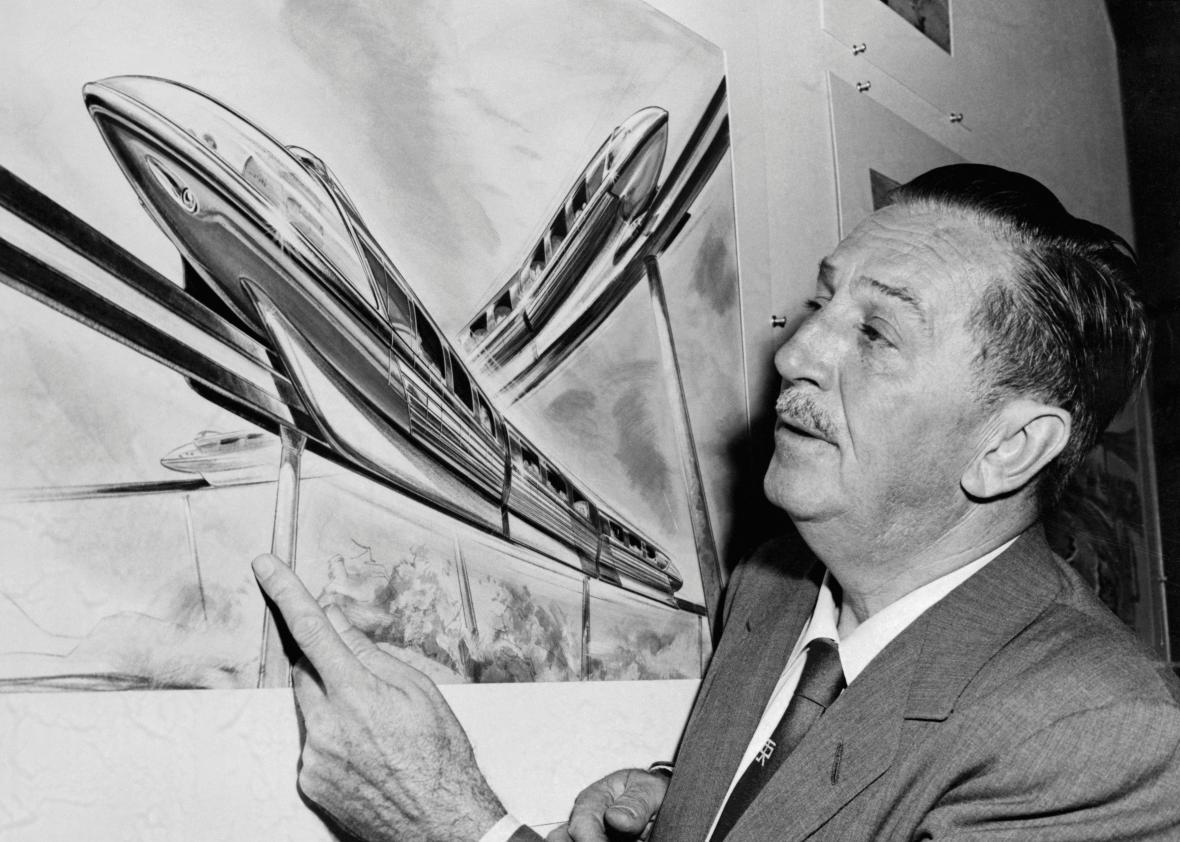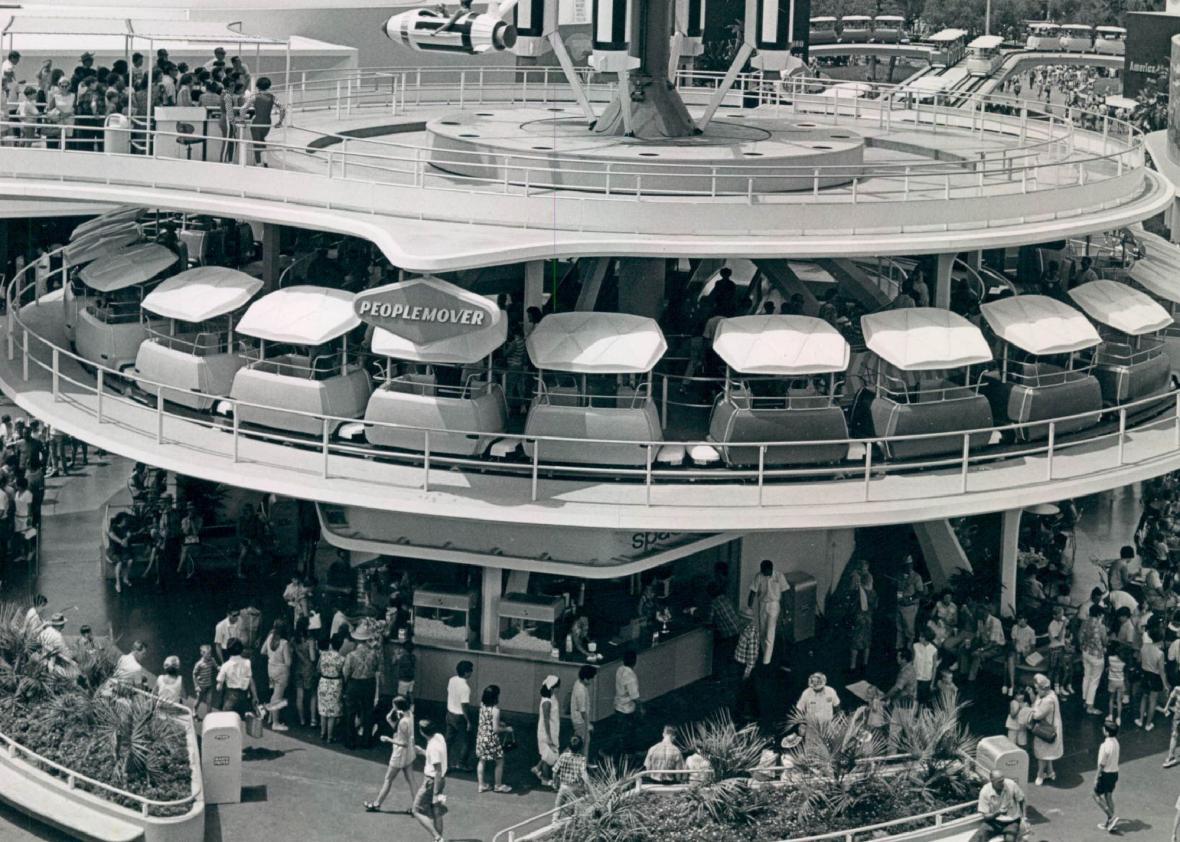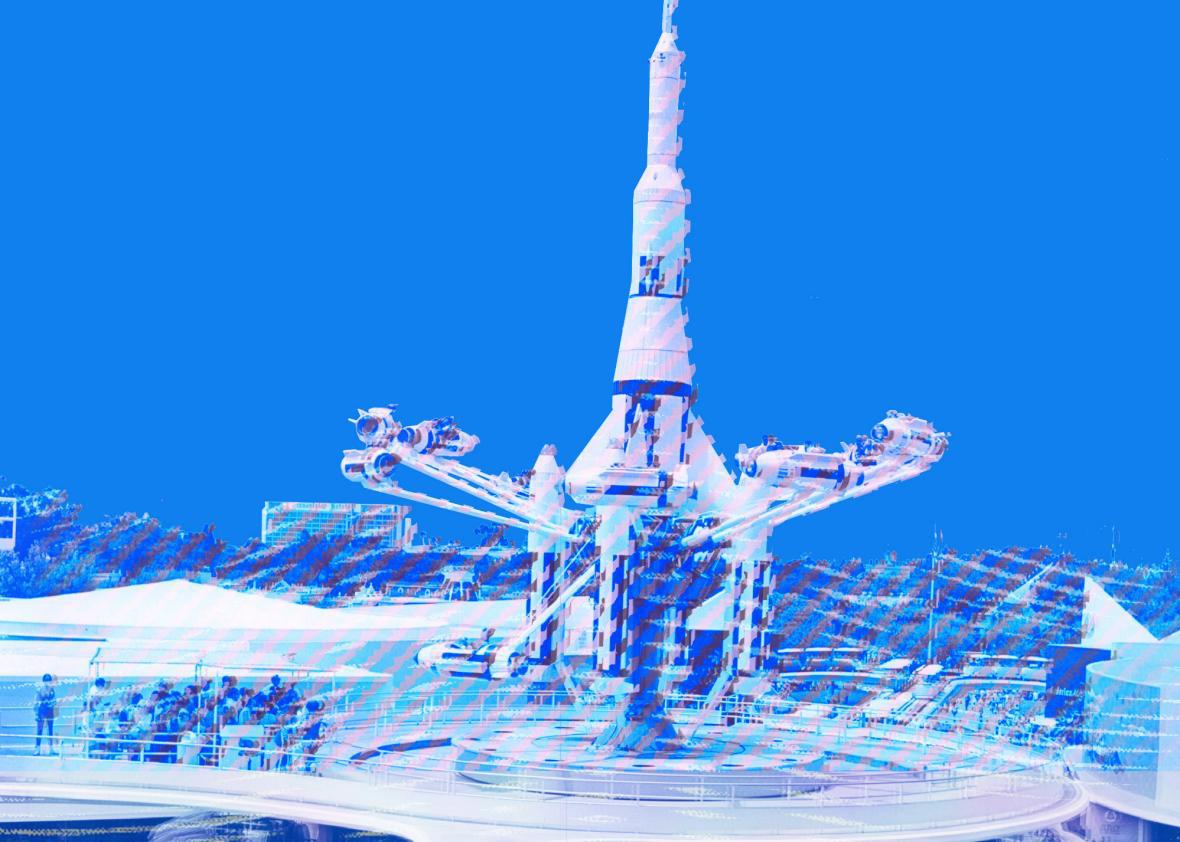When Disneyland opened its doors in Anaheim, California, on July 17, 1955, the word astronaut was not yet a household term. But a bright white rocketship towered over Tomorrowland (and, in fact, the entire park), poised to blast off into soon-to-be explored galaxies. Behind it stood a geometric space station, red letters over the entrance labeling it “Rocket To The Moon,” with two large spherical theatres jutting from the rear. Though it would be almost 14 years to the day before Neil Armstrong would take that one giant leap for mankind, Disneyland visitors would soon get close, experiencing a thrilling virtual trip around the moon and back again.
The Clock of the World, an extravagant chronometer telling visitors the exact minute and hour anywhere in the world, stood by the entrance to Tomorrowland, symbolizing the land’s temporal transition. According to a 1955 Disneyland insert in the Los Angeles Examiner, “1955 becomes 1986 as you enter the new era—Tomorrowland where our hopes and dreams for the future become today’s realities.” Shiny metallic orbs, symbols of the Atomic Age, clustered around poles and decorated the futuristic buildings. Inside those buildings, visitors could find innovative technology—Circarama, U.S.A. showed a 360-degree film, the first of its kind, over a ring of nine encircling screens, while Space Station X-1 gave visitors a “satellite view” of Earth, two years before Sputnik would be launched into space. Autopia, which became a Disneyland icon, celebrated cars and the American freeway, one year before President Eisenhower was to sign the National Interstate and Defense Highways Act into law.
The future was exciting, optimistic, radiant, and at Tomorrowland, it was a place you could visit and enjoy, marveling at what was to come.
But at some point in the last six decades, Tomorrowland went from a land of possibility to a land of nostalgia. Today, on that same land in Anaheim, California, stands a retrofuturistic attraction, full of old-fashioned, cutesy ways of thinking about space travel, transportation, and robots. Even the 2015 Tomorrowland movie flopped. Disneyland seems to have lost its passion for futurology, letting what was once an innovative, optimistic, imaginative Tomorrowland slip into a symbol of yesteryear. What happened to Walt’s Tomorrow?
Walt Disney—storyteller, visionary, and one of Time’s 20 most influential innovators of the 20th century—saw the future as a wondrous and magical place. He embraced new technology throughout his career: His early animations used what were then cutting-edge effects, such as color and sound, and he was obsessed with mass transit, with the concept for Disneyland coming out of his passion for increasingly large model trains. Plus, he loved outer space. From 1954 to 1958, he hosted Disneyland, a weekly show on ABC, to finance the park’s construction. His passion for futurology came across in his Tomorrowland segments:
Tomorrowland, referred to in early plans as The Land of Tomorrow and envisioned by Walt to be “the factual and scientific exposition of things to come,” was one of four imaginative realms that park-goers could visit (Fantasyland, Adventureland, Frontierland, and Tomorrowland). Walt Disney always intended his park to be educational as well as entertaining. In his Tomorrowland dedication speech, displayed in the park to this day, Walt promised the land would be a:
vista into a world of wondrous ideas, signifying man’s achievements … a step into the future, with predictions of constructive things to come. Tomorrow offers new frontiers in science, adventure and ideals: the Atomic Age … the challenges of outer space … and the hope for a peaceful and unified world.
But the problem with the designing the world of tomorrow soon became apparent: Tomorrow very quickly becomes today, and then yesterday. The future never stays that way for long.
For a time, the Walt Disney Co. attempted to keep up. Incomplete upon opening, most of Tomorrowland’s original attractions were actually temporary corporate installations rushed in time for the launch—but Walt never intended for his park to remain static. The forward-thinking entrepreneur and his team of Imagineers continued to tinker with Tomorrowland through the ’50s and ’60s, keeping it not just up-to-date but ahead-of-the-date, one step ahead of the rapidly encroaching future. Tomorrowland addressed all the major scientific advancements of the midcentury as they unfolded: space travel, submarines, the freeway, the monorail, and nuclear power.

Bettmann/Getty Images
Walt, a Republican in his later years, believed firmly in the innovative power of the free market and formed close relationships with American industries. Of the four lands, Tomorrowland was the greatest benefactor of these corporate partnerships, becoming the most heavily sponsored area in the park: The Hall of Chemistry was sponsored by Monsanto, and the Hall of Aluminum Fame by Kaiser Aluminum, while the Bathroom of Tomorrow was basically a giant ad for Crane Plumbing: “This fabulous bathroom, actually designed for the future, is available for your home today!”
Monsanto sponsored another attraction in 1957, the House of the Future, which remains one of Tomorrowland’s most iconic attractions. The strange plastic house was home to household gadgets that today seem commonplace—a flat-screen TV, a microwave oven—but would not be available to 1957 audiences for many years to come. At the Monsanto House of the Future, Junior could try out the (public) electric toothbrush:
In 1959, Tomorrowland became home to the first permanent monorail in the Western Hemisphere, the Disneyland-ALWEG Monorail System. Walt Disney invited then–Vice President Richard Nixon and his family to open the attraction. The monorail, and the 1967 PeopleMover to follow, were more than simply rides to Walt: They were policy suggestions. In his letter to Nixon, he wrote that the mode of transport was a “prototype of a rapid transit system which many solve many of the traffic problems of our modern day.” He was frustrated when Los Angeles policymakers did not follow his lead.
After a decade of adding and subtracting attractions while leaving the core in place, Tomorrowland’s “tomorrow” had begun to feel antiquated—much of its future forecast had already come true, making it time for an overhaul. Between 1964 and 1967, $20 million was spent demolishing and rebuilding the land, more than the cost of the entire 1955 theme park. Though he would not live to see it completed, Walt was heavily involved in New Tomorrowland’s design, and his futuristic fingerprints were all over it when it opened on July 18, 1967.
A grand reopening was held, and it seemed Tomorrowland’s optimism was back: Astro Mickey, wearing a space helmet built to accommodate his ears, waved from the stage, while a human astronaut hovered over the park by jetpack, which is cool even by today’s standards. New attractions included the scientific Adventures Thru Inner Space, a microscope-themed ride in which guests were “shrunk” to the size of an atom, and the glorious Carousel of Progress, designed by Walt himself, a rotating theater showing—to the tune of “There’s a Great Big Beautiful Tomorrow”—how industrial advances had improved the lives of generations of (audio-animatronic) American families. Yellow, red, and blue carriages ferried park-goers along white overhead conveyer belts in the Goodyear-sponsored PeopleMover (“Ride Tomorrow’s Transportation… Today”).
The ’70s and ’80s brought more incremental change. In 1975, Rocket/Flight to the Moon was changed to Mission to Mars as the moon landing six years prior had dated the attraction. In 1986, one of the world’s first 4-D films opened at Disneyland, starring amusement park aficionado Michael Jackson. Shot on Disney’s state-of-the-art 3-D camera and accompanied by in-theater smoke and laser effects, Captain Eo was—at the time—the most expensive film per minute ever made. (Each minute cost $17.6 million.)
In the early ’90s, plans were drawn up for another radical Tomorrowland revamp, “Tomorrowland 2055” (2055 being the year Disneyland will turn 100). However, budget cuts caused by the poor performance of Euro Disneyland—which featured its own intentionally retrofuturist “Discoveryland” inspired by the writing of Jules Verne and H.G. Wells—caused the Walt Disney Co. to shelve the “2055” plans. In 1998, Tomorrowland went fully retro, repainted in browns and golds similar to those of Discoveryland’s cartoonish mechanical instruments. For Disneyland’s 50th anniversary in 2005, Tomorrowland was repainted to a modern white, silver, and blue color scheme, which remains to this day.
Walt Disney wasn’t just interested in capturing the future: He was interested in creating it. In the final months of his life, he was hard at work on a new concept, his most ambitious to date. The Experimental Prototype Community of Tomorrow was to be a living breathing city of the future, “the world’s first futuristic metropolis,” on land Disney had purchased in Florida. Walt wanted to build an urban laboratory—population 20,000—with which to solve America’s “urban crisis”: congestion, pollution, civil unrest, and lack of community. By now used to the difficulty involved in keeping the tomorrow in Tomorrowland, Disney declared that EPCOT would never be completed: It would be in a permanent state of “becoming,” forever in progress.
Today’s Epcot is far from the one Walt envisioned. After his death in 1966, the land put aside for the model city became part of Florida’s Walt Disney World instead. Disney World visitors can still check out the Epcot Center, a theme park dedicated to human achievement and international culture, sometimes likened to a permanent world’s fair, and resembling Walt’s EPCOT in name only.
Building an experimental city from scratch was always going to be a complex, expensive, problematic task—even Walt would have struggled to pull this one off. But the Walt Disney Co. seems to have abandoned all efforts at serious futurology. Since the abandonment of the “2055” project, the original Tomorrowland—home of Walt’s starry-eyed vision of space, atoms, and transit—has displayed little of Walt’s futuristic spirit. The park’s current “Googie” architecture is a relic from the past, “a space age look that was enormously popular during the 1950s,” according to the Disney website. The rides are a mixture of vintage classics (Autopia, the monorail, and the submarine still run) and Pixar/Star Wars–themed attractions that are more science-fiction than science-future. The most future-focused science at Tomorrowland today is also the least technological: The “visionary landscaping” is edible, representing an “ecologically astute future where humanity makes the most of its resources.” Hipsters rejoice. It’s been almost two decades since Tomorrowland debuted an attraction focused on scientific discovery.

Denver Post via Getty Images
Projecting the future is a difficult, expensive, not to mention never-ending task—but not an impossible one. If 1960s Imagineers could overhaul their 1950s ideas to create New Tomorrowland, why are we here in the 21st century stuck in Never-Never Land? After decades of trying to keep up with ever-accelerating technology, Disney seems to have embraced the stagnant future of the past.
What might Tomorrowland be like if its mission continued today? In the months leading up to his 1966 death, Walt was obsessed with finding solutions to the “urban crisis,” which he saw as the greatest challenge of his day, spending his free time reading books on urban planning. Would he bring the same zeal to designing today’s smart cities, or developing clean energy? A friend to industry and a fan of NASA, would the Walt of 2017 be partnering with Google and Apple? Would Autopia now feature self-driving, voice-operated cars? It’s hard to imagine Tomorrowland would be remain stuck in the past for long with Walt at the wheel.
If there is a Walt Disney of 2017, it might be Elon Musk. The Tesla and SpaceX founder shares Walt’s starry-eyed foresight, his dual passion for interplanetary travel and redefining transport here on Earth. Born seven decades apart, Musk’s dreams of Mars and the Hyperloop don’t seem so different to Walt’s 1950s fantasies—though we’ve now been imagining that next small step/giant leap for so long that even journeying to Mars feels too retrofutury for Disneyland.
So why isn’t the Walt–Elon vision of the future to be found in today’s Tomorrowland? Perhaps it’s not the Disney Co. Perhaps it’s us. Tech doesn’t exactly wow us like it used to—after all, it’s now in our homes, in our cars, even in our pockets. Touristing in a technological wonderland would probably feel underwhelming, considering we’re basically already in one. And why would anyone want to immerse themselves in the future? Popular imagination holds that today’s future will be a dystopia, not a utopia. In this age of climate-change doom and job-killing automation, of “unplugging” and “logging off,” perhaps the future is no longer a place we want to go, no longer the land of exciting promise, of “hopes and dreams.” In the 1950s, the future was an inviting fantasy, something to gaze towards, to marvel at, to reach for. Now Walt’s tomorrow is here … and well, we’re drowning in it.
This article is part of Future Tense, a collaboration among Arizona State University, New America, and Slate. Future Tense explores the ways emerging technologies affect society, policy, and culture. To read more, follow us on Twitter and sign up for our weekly newsletter.
